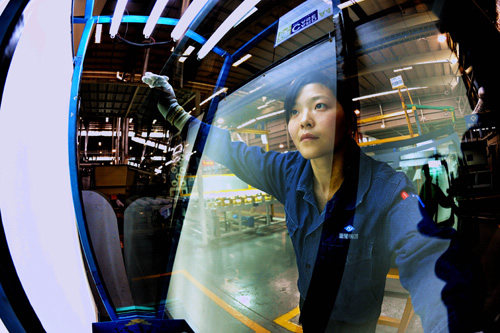|
 |
|
IN THE WORKSHOP: A worker checks glass products at a Fuzhoubased glass company in Fujian Province on April 8, 2011 (XINHUA) |
Speculators have recently been fixated on the share price of Luoyang Glass. The attention has put a strain on its chief executive officer Song Jianming, who is afraid that unusual fluctuations in the trading of shares will affect normal operations.
The State Council has approved the launch of glass futures trading at the Zhengzhou Commodity Exchange. In the past month, almost all the listed glass manufacturers, except Luoyang Glass, have undergone fluctuations triggered by rumors about glass futures.
Different from these glass manufacturers, the Zhengzhou Commodity Exchange is mainly concerned with whether the trading system of glass futures is viable.
Since the start of China's futures market in the 1990s, China has followed on the heels of developed countries. By the first half of 2012, China had launched 26 futures products, encompassing bulk stock and agricultural products.
Lu Yong, an analyst from Guodu Futures, suggested that the launch of the world's first glass futures will have a significant impact on the glass industry and even the futures market.
The trading of glass futures in Zhengzhou Commodity Exchange would play a guiding role in the pricing of glass both at home and abroad.
Innovation
Lu believes the release of glass futures indicates that China has independent views on the development of financial derivatives. Instead of targeting exclusively the most prominent investors, the contract unit of glass futures is fixed at 20 tons, making it more convenient for all investors to complete transactions.
Even though there are as many as 3,400 glass companies in China, most distributors and deep-processing enterprises are very small. A large contract size will undoubtedly force small and medium-sized glass enterprises out of the futures market.
Moreover, it is more convenient for carriers to transport glass products and for investors to make deals. Trucks and railways are the most frequently employed means of transportation in the glass industry, and the loading capacities of trucks and railway wagons are 40 tons and 60-70 tons respectively.
In this sense, the contract size of 20 tons is reasonable. Furthermore, the average price of glass has been 2,000 yuan ($321) per ton in the last two years, and if the security deposit of 10 percent is included—the highest rate required by futures firms—the price rises to 4,000 yuan ($642) to trade one contract unit, which enables the glass futures to attract investors on a more extensive scale.
Moreover, deals can be reached without transporting glass products to third-party warehouses. As glass products are fragile and large in surface area, it's difficult to find glass warehouses.
Factory delivery can better meet the purchasers' needs. Since downstream glass firms always make purchases according to orders, factory warehouses can supply them with products of various specifications.
Files from the Zhengzhou Commodity Exchange also suggest the new trading pattern allows purchasers to take delivery of glass products directly from the factory, significantly cutting transportation and loading costs and avoiding possible damage to glass products.
Pricing power
China has ranked first place in plate glass output for 23 straight years. Will the first glass futures give China a leg up in gaining pricing power?
According to a study by Zhang Yumin, an analyst from Minmetals Futures, the top 10 glass manufacturers in China only account for 39 percent of the total, a relatively low rate of industrial concentration. The eastern regions control 86 percent of the total plate glass capacity, highlighting serious market segmentation.
Therefore, while China is the largest glass manufacturer in the world, segmentation has weakened its clout, hindering its ability to gain pricing power. The launch of glass futures will improve the pricing mechanism of glass products.
| 